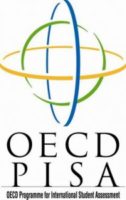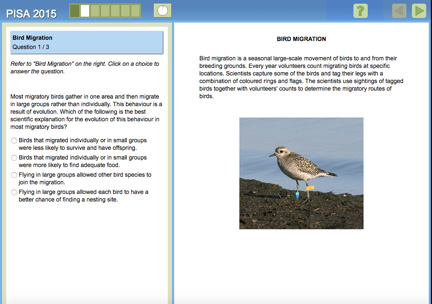Who invented PISA and why?
PISA is the br ainchild of the Organization for Economic Cooperation and Development (OECD), a highly respected intergovernmental entity created after World War Two with the mission [1] “to promote policies that will improve the economic and social well-being of people around the world.” Given the vital importance of education to human development as a whole, the OECD created PISA 15 years ago to shed light on what participating countries are doing well in their educational systems and also what they can learn from others’ approaches. Accomplished educational experts from across the globe pool their competencies to co-design the evaluation in question, under the thoughtful leadership of a researcher at the OECD named Andreas Schleicher [2]. By asking a statistically significant sample of students throughout the world to take the same test and to do so at a regular intervals, the goal is to yield insights into effective educational strategies wherever they might be located and to allow nations to gauge their progress towards the attainment of such educational excellence over time.
ainchild of the Organization for Economic Cooperation and Development (OECD), a highly respected intergovernmental entity created after World War Two with the mission [1] “to promote policies that will improve the economic and social well-being of people around the world.” Given the vital importance of education to human development as a whole, the OECD created PISA 15 years ago to shed light on what participating countries are doing well in their educational systems and also what they can learn from others’ approaches. Accomplished educational experts from across the globe pool their competencies to co-design the evaluation in question, under the thoughtful leadership of a researcher at the OECD named Andreas Schleicher [2]. By asking a statistically significant sample of students throughout the world to take the same test and to do so at a regular intervals, the goal is to yield insights into effective educational strategies wherever they might be located and to allow nations to gauge their progress towards the attainment of such educational excellence over time.
Who takes this survey and what is on it?
In 2015, more than half a million students, aged 15 and coming from 72 different countries, took this two-hour, triennial evaluation of knowledge and above all skills in the following main areas: science, mathematics, reading, collaborative problem-solving and financial literacy. NB. the OECD will be adding intercultural competency to the mix three years from now. To get a sense of the test, you might endeavor to answer the following question, taken from the field of science. Click here [3] for more questions from the past tests.

What precisely does PISA measure?
The short answer: critical thinking, which is probably the cognitive ability that is most often cited by educators as being the linchpin of lifelong learning. As Amanda Ripley, an investigative journalist and the author of a thought-provoking book entitled The Smartest Kids in the World and How They Got That Way, wrote in the New York Times [4] last Tuesday, “unlike other exams, the PISA, as it is known, does not assess what teenagers have memorized. Instead, it asks them to solve problems they haven’t seen before, to identify patterns that are not obvious and to make compelling written arguments. It tests the skills, in other words, that machines have not yet mastered.” According to Andreas Schleicher, PISA focuses [5] “on student skills – what they can do with what they know. In the 2015 cycle we have built on this, asking whether students can think like a scientist, reason like a mathematician and distinguish between good and bad arguments in a written text.”
Does it do a good job of evaluating what it seeks to evaluate?
Since its creation at the turn of the 21st century, there has been debate about PISA, most often around such matters as the adequacy of its sample size, the attention it devotes to science and mathematics as compared to other domains, the possibility of cultural bias being built into its form and content, the effects which translation might have on student outcomes, to note just some of the criticism which this evaluation has needed to confront for the last decade and a half. On the whole, however, this evaluation has acquired an extraordinary reputation for both seriousness and usefulness. For Mattea Battaglia and Aurélie Collas [6], who cover education for Le Monde, “En réalité, peu de chercheurs mettent aujourd’hui en doute la robustesse de cette enquête et la fiabilité de ses résultats. On sait que les correcteurs de tous pays sont sélectionnés, formés, ils ont des consignes, des guides de correction… Un contrôle est effectué à l’issue de la passation des tests sur un échantillon de copies pour vérifier l’harmonisation des scores… S’agissant des questions elles-mêmes, reste le soupçon du « biais culturel » : le fait que certaines questions colleraient plus à un système scolaire qu’à un autre. PISA tente d’atténuer cet aspect en demandant à chaque pays de contribuer à l’élaboration du questionnaire.”
Does PISA hold any relevance for individual schools?
Yes. PISA is renowned for its capacity to inform and influence the ways in which whole societies think and talk about education, not to mention the manner in which individual governments conceive of and develop their educational policies over time. For many countries, the survey has been a veritable wake-up call to educational realities which might not otherwise have been as readily apparent or even politically palatable to accept. Yet PISA is also remarkably helpful for schools, not because our students will necessarily take this test themselves, but because they will one day need to flourish in a world in which the skills PISA evaluates must be mastered. As such, the survey sheds light on the goals we should be adopting when developing our curricula. PISA has also been salutary in guiding educators towards models of education that are inspiring and effective benchmarks for teaching and learning on any scale. It is thanks to this test, for instance, that Finnish educational practices [7] have garnered worldwide attention and emulation, leading to progress in elementary and secondary schools around the world.
About the Author :
Sean Lynch was Head of School at the Lycée Français de New York from 2011 to 2018, after having spent 15 years at another French bilingual school outside of Paris: the Lycée International de St. Germain-en-Laye. Holding both French and American nationalities, educated in France (Sciences Po Paris) and the United States (Yale), and as the proud husband of a French-American spouse and father of two French-American daughters, Sean Lynch has spent his entire professional and personal life at the junction between the languages, cultures and educational systems of France and the United States. In addition to being passionate about education, he loves everything related to the mountains, particularly the Parc National du Mercantour.